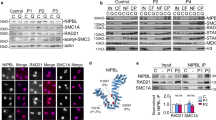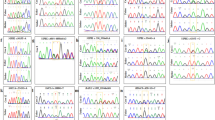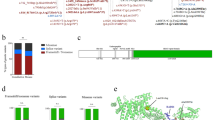Abstract
Cornelia de Lange syndrome (CdLS) is a rare multisystemic congenital anomaly disorder that is characterised by intellectual disability and growth retardation, congenital heart defects, intestinal anomalies, facial dysmorphism (including synophyris and high arched eyebrows) and limb reduction defects. Mutations in three cohesin-associated genes encoding a key regulator (NIPBL, chr 5p13.2) and one structural component of the cohesin ring (SMC1A, chr Xp11) occur in about 65% of CdLS patients. NIPBL is the major causative gene, and accounts for 40–60% of CdLS patients as shown by a number of mutational screening studies that indicate a wide mutational repertoire of mainly small deletions and point mutations. Only a few data are available concerning the occurrence of large NIPBL rearrangements or intragenic deletions or duplications involving whole exons. We used multiplex ligation-dependent probe amplification (MLPA) to study 132 CdLS patients negative to the standard mutation NIPBL test out of a cohort of 200 CdLS patients. A total of 7 out of 132 patients were found to carry NIPBL alterations, including two large gene deletions extending beyond the gene, four intragenic multi- or single-exon deletions and one single-exon duplication. These findings show that MLPA leads to a 5.3% increase in the detection of mutations when used in addition to the standard NIPBL scan, and contributes per se to the molecular diagnosis of 3.5% (7/200) of clinically diagnosed CdLS patients. It is recommended that MLPA be included in the CdLS diagnostic flow chart.
Similar content being viewed by others
Log in or create a free account to read this content
Gain free access to this article, as well as selected content from this journal and more on nature.com
or
References
Krantz ID, McCallum J, DeScipio C et al: Cornelia de Lange syndrome is caused by mutations in NIPBL, the human homolog of Drosophila melanogaster Nipped-B. Nat Genet 2004; 6: 631–635.
Tonkin ET, Wang TJ, Lisgo S, Bamshad MJ, Strachan T : NIPBL, encoding a homolog of fungal Scc2-type sister chromatid cohesion proteins and fly Nipped-B, is mutated in Cornelia de Lange syndrome. Nat Genet 2004; 36: 636–641.
Musio A, Selicorni A, Focarelli ML et al: X-linked Cornelia de Lange syndrome owing to SMC1L1 mutations. Nat Genet 2006; 38: 528–530.
Yan J, Saifi GM, Wierzba TH et al: Mutational and genotype-phenotype correlation analysis in 28 polish patients with Cornelia de Lange syndrome. Am J Med Gen 2006; 140: 1531–1541.
Bhuiyan ZA, Klein M, Hammond P et al: Genotype-phenotype correlations of 39 patients with Cornelia de Lange syndrome: the Dutch experience. J Med Gen 2006; 43: 568–575.
Deardorff MA, Kaur M, Yaeger D et al: Mutations in cohesin complex members SMC3 and SMC1A cause a mild variant of Cornelia de Lange syndrome with predominant mental retardation. Am J Hum Genet 2007; 80: 485–494.
Selicorni A, Russo S, Gervasini C et al: Clinical score of 62 Italian patients with Cornelia de Lange syndrome and correlations with the presence and type of NIPBL mutation. Clin Genet 2007; 72: 98–108.
Hayashi S, Ono M, Makita Y, Imoto I, Mizutani S, Inazawa J : Fortuitous detection of a submicroscopic deletion at 1q25 in a girl with Cornelia de Lange syndrome carrying t(5;13)(p13.1;q12.1) by array-based comparative genomic hybridization. Am J Med Genet A 2007; 143A: 1191–1197.
Schoumans J, Wincent J, Barbaro M et al: Comprehensive mutational analysis of a cohort of Swedish Cornelia de Lange syndrome patients. Eur J Hum Genet 2007; 15: 143–149.
Gervasini C, Pfundt R, Castronovo P et al: Search for genomic imbalances in a cohort of 24 Cornelia de Lange patients negative for mutations in the NIPBL and SMC1L1 genes. Clin Genet 2008; 74: 531–538.
Vrouwe MG, Elghalbzouri-Maghrani E, Meijers M et al: Increased DNA damage sensitivity of Cornelia de Lange syndrome cells: evidence for impaired recombinational repair. Hum Mol Genet 2007; 16: 1478–1487.
Bhuiyan ZA, Stewart H, Redeker EJ, Mannens MM, Hennekam RC : Large genomic rearrangements in NIPBL are infrequent in Cornelia de Lange syndrome. Eur J Hum Genet 2007; 15: 505–508.
Ratajska M, Wierzba J, Pehlivan D et al: Cornelia de Lange syndrome case due to genomic rearrangements including NIPBL. Eur J Med Genet 2010; 53: 378–382.
Kline AD, Krantz ID, Sommer A et al: Cornelia de Lange syndrome: clinical review, diagnostic and scoring systems, and anticipatory guidance. Am J Med Genet A 2007; 143A: 1287–1296.
Lichter P, Cremer T : Chromosome analysis by non-isotopic in situ hybridization; in: Rooney DE and Czipolkowski BH (eds):: Human Cytogen-A Practical Approach. Oxford: University Press, 1992, pp 157–192.
Yan J, Zhang F, Brundage E et al: Genomic duplication resulting in increased copy number of genes encoding the sister chromatid cohesion complex conveys clinical consequences distinct from Cornelia de Lange. J Med Genet 2009; 46: 626–634.
Taylor MJ, Josifek K : Multiple congenital anomalies, thymic dysplasia, severe congenital heart disease, and oligosyndactyly with a deletion of the short arm of chromosome 5. Am J Med Genet 1981; 9: 5–11.
Hulinsky R, Byrne JL, Lowichik A, Viskochil DH : Fetus with interstitial del(5)(p13.1p14.2) diagnosed postnatally with Cornelia de Lange syndrome. Am J Med Genet A 2005; 137A: 336–338.
Kirschner MA, Arriza JL, Copeland NG et al: The mouse and human excitatory amino acid transporter gene (EAAT1) maps to mouse chromosome 15 and a region of syntenic homology on human chromosome 5. Genomics 1994; 22: 631–633.
Jen JC, Wan J, Palos TP, Howard BD, Baloh RW et al: Mutation in the glutamate transporter EAAT1 causes episodic ataxia, hemiplegia, and seizures. Neurology 2005; 65: 529–534.
de Vries B, Mamsa H, Stam AH et al: Episodic ataxia associated with EAAT1 mutation C186S affecting glutamate reuptake. Arch Neurol 2009; 66: 97–101.
Dorsett D, Krantz ID : On the molecular etiology of Cornelia de Lange syndrome. Ann NY Acad Sci 2009; 1151: 22–37.
Gillis LA, McCallum J, Kaur M et al: NIPBL mutational analysis in 120 individuals with Cornelia de Lange syndrome and evaluation of genotype-phenotype correlations. Am J Hum Gene 2004; 75: 610–623.
Pié J, Gil-Rodríguez MC, Ciero M et al: Mutations and variants in the cohesion factor genes NIPBL, SMC1A, and SMC3 in a cohort of 30 unrelated patients with Cornelia de Lange syndrome. Am J Med Genet A 2010; 152A: 924–929.
Oliveira J, Dias C, Redeker E et al: Development of NIPBL locus-specific database using LOVD: from novel mutations to further genotype-phenotype correlations in Cornelia de Lange syndrome. Hum Mutat 2010; 31: 1216–1222.
Acknowledgements
We would like to thank the patients’ families for participating in this study, and acknowledge the support of ISS rare disease Grant 526/A27 to LL, project ‘Clinical, functional, behavioural and genetic characterisation of new candidate genes of the cohesin–condensin complex’.
Author information
Authors and Affiliations
Corresponding author
Ethics declarations
Competing interests
The authors declare no conflict of interest.
Additional information
Supplementary Information accompanies the paper on European Journal of Human Genetics website
Supplementary information
Rights and permissions
About this article
Cite this article
Russo, S., Masciadri, M., Gervasini, C. et al. Intragenic and large NIPBL rearrangements revealed by MLPA in Cornelia de Lange patients. Eur J Hum Genet 20, 734–741 (2012). https://doi.org/10.1038/ejhg.2012.7
Received:
Revised:
Accepted:
Published:
Issue date:
DOI: https://doi.org/10.1038/ejhg.2012.7
Keywords
This article is cited by
-
Diagnosis and management of Cornelia de Lange syndrome: first international consensus statement
Nature Reviews Genetics (2018)
-
Electroclinical characteristics and neuropsychological profile of a female child with chromosome 5p13.2 duplication syndrome
Neurological Sciences (2017)
-
Genomic imbalances in patients with a clinical presentation in the spectrum of Cornelia de Lange syndrome
BMC Medical Genetics (2013)
-
Cornelia de Lange Syndrome: NIPBL haploinsufficiency downregulates canonical Wnt pathway in zebrafish embryos and patients fibroblasts
Cell Death & Disease (2013)
-
Spectrum of NIPBL gene mutations in Polish patients with Cornelia de Lange syndrome
Journal of Applied Genetics (2013)



